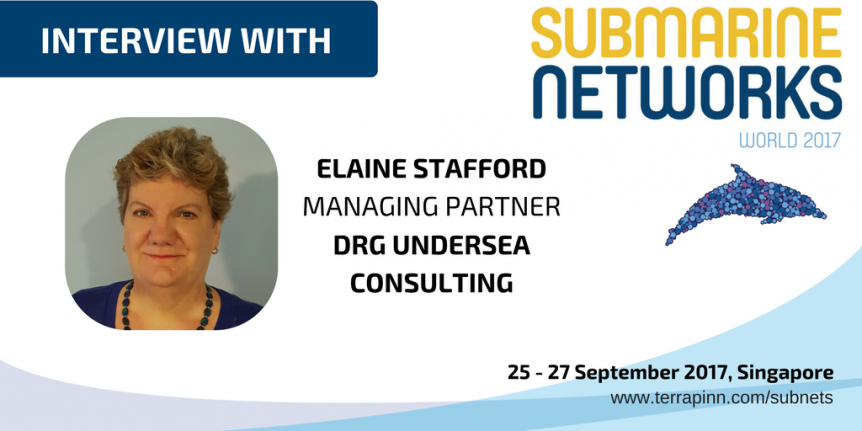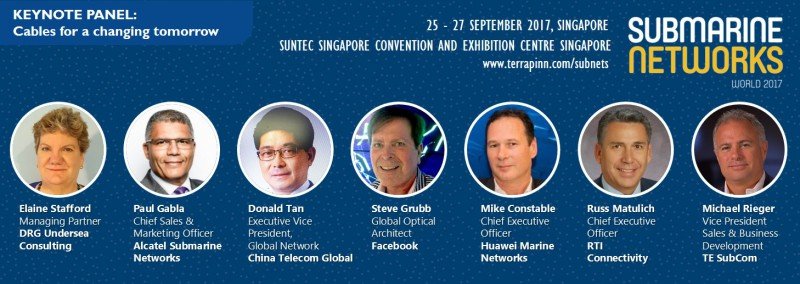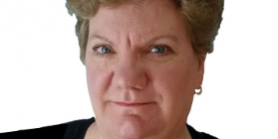 Joining our interview line-up is another familiar face to many in the subsea communications space –Elaine Stafford from DRG Undersea Consulting. Having been involved in the planning, development, design, engineering, and implementation of undersea fiber-optic cable system projects worldwide since the early 1980s, it’s safe to say that Elaine has seen the industry go through its fair share of highs and lows.
Joining our interview line-up is another familiar face to many in the subsea communications space –Elaine Stafford from DRG Undersea Consulting. Having been involved in the planning, development, design, engineering, and implementation of undersea fiber-optic cable system projects worldwide since the early 1980s, it’s safe to say that Elaine has seen the industry go through its fair share of highs and lows.
Yet she remains ever excited about the business (it’s hard not to sense it when you speak one-on-one with her!), and stays actively involved through her various contributions in PTC, SubOptic and Submarine Networks World on top of her day to day work. We caught up with Elaine recently where she shares her thoughts on the industry’s development and where she thinks we’re headed.
1. Tell us more about yourself (and your organisation)
After developing submarine cable products, engineering solutions, selling systems and project-managing network implementation for over 35 years, the thing that continues to make this business exciting for me, and I think also my colleagues at DRG Undersea Consulting, is meeting and working with new people across the globe and using our knowledge and experience to help our clients to make better decisions.
Each new project we work on has its own set of challenges- whether they’re technical, commercial, political, or relationships. Figuring out with our clients how best to push, leverage, and adjust various parameters/tradeoffs to come up with the best overall solution is not only worthwhile, but fun, too. Sometimes, we’re lucky enough also to be part of a project that brings cables to places they’ve never been before, which of course, supports the development of that remote area and the people there; that really makes it all worthwhile.
These are the things that get me to turn on my PC every morning and pull me into the day ahead… helping others solve problems that allow projects to move forward better.
2. In one sentence, how would you describe the state of the subsea communications industry today?
Extraordinarily exciting as it explodes with new cable routes, new purchasers, new network architectures … all getting closer to supporting integrated global solutions reaching nearly every economy, yet still challenged by both the uniqueness of the undersea environment, idiosyncrasies of international business and the dynamics of rapidly evolving communications industry as a whole.
3. How do you see the industry evolving in the next 5 years?
I believe that there will be more new cables built in the coming years than we’ve seen in some time, but the industry will continue to evolve in terms of who owns and operates cables. The OTTs are managing their own, huge volumes of capacity demand through direct network investment. As a result, the carriers’ wholesale capacity opportunities are not growing like they used to.
It will be especially interesting to see how this sorts out in the smaller markets. To me, what is even more interesting is how global capacity prices may change as a result. Some important, traditional enablers of annual capacity price erosion are diminishing and thus I wonder whether the market behavior will support a slowing of the historic rate of price decline. I believe the current business models will require this to maintain balance. If not, business models will need to evolve, but in what way is a big unknown.
4. What do you think is one key challenge facing the industry today? How do you think it can be overcome?
We all know that a never-ending industry challenge is financing new cables- securing the backers with funds to build. Simply because these market dynamics are changing, yet despite today’s massive demand for international communication, I expect financing to continue to be a challenge. Once that challenge is met, a cable faces another ever-present challenge- permitting. Our industry has always been challenged by the need to secure the permits which are required to construct and maintain new networks. This impacts a cable’s on-time delivery, construction cost, repair time and operations cost. In today’s complex political environment, while some countries are treating cables as “critical infrastructure” and using this classification to ease some of these challenges, regulations in other jurisdictions seem to be making it the challenges even greater. I think somehow the industry needs to find a way to cooperate, like never before, to explore new ways of easing these challenge for submarine cables.
5. You’ll be moderating the panel “Cables for a changing tomorrow” at the conference, name one thing that you believe will stay the same, and one thing that will definitely change when it comes to building cables in the future
Personally, I am a firm believer that quality and reliability are critical to undersea cables- in nearly every aspect of their design, construction and OA&M, and will remain so. As a result, I believe system suppliers and service providers must continue to make quality an overarching imperative of their business. I say this on the basis that the impact of a cable fault is so significant from both a network/service availability and cost perspective, that it is hard for me to imagine that the communications industry will embrace, even with expanding mesh networks, a significant increase in the number of cable faults. Thus, I think cable reliability requirements will remain stringent.
As for what will change, I expect that cable investment models and accompanying management models will continue to evolve. In the last few years, we’ve seen the OTT’s drive “co-builds” with ownership based on fiber-pairs. I expect others who want to own cables (or cost-based capacity on cables), but who may not individually want to invest in a whole pair, may instead invest as a group in one or two shared pairs within a cable where the OTT’s own individual pairs. I cannot imagine, however, that the OTTs will support managing projects with large committees typical of consortia. Thus, I think there will be an accompanying evolution and perhaps simplification of management structures. One might say this is not new, as there have been some very unique cable investment models historically- including some which similarly blended varied interests in investment levels. However, I think the market will come up with some new approaches, as well. One question that will need to be addressed in all of this is how much control individual owners/investors are willing to cede to others. I’ve yet to see a cable investor who does not struggle with managing the balance between the cable investment group’s interests with their own corporate control procedures.
6. Why are you excited to be at Submarine Networks World 2017?
This is, I believe, the 20th year for SNW. I’ve attended periodically over the years, but consistently for the past several years and have seen the content and attendance get bigger and better year over year. It is one of the few, established international conferences that focuses on the submarine cable industry. I can count on hearing lively discussion and informative presentations, as well as one-on-one discussions with many important market leaders. I value the opportunity to chair a panel at SNW and support debate about important topics between the panelists and the audience. I always walk away from SNW with new and important insights myself.
I know there are several other new conferences being planned which will focus on our industry. As time moves forward, depending on how those forums progress, it may be difficult to choose which conferences to attend, as not many of us can afford to attend as many as are planned. Right now, SNW is up there as one of the ‘must attends’ for me and it is hard, for me, to see this changing.
Elaine will be moderating the opening keynote panel “Cables for a changing tomorrow” on Day One, 26 September, alongside the following speakers at Submarine Networks World 2017 (25-27 September, Suntec Singapore Convention Centre).
 Join her together with over 500 industry leaders at the only annual platform dedicated for the subsea communications community to meet, exchange knowledge and develop new strategies and partnerships.
Join her together with over 500 industry leaders at the only annual platform dedicated for the subsea communications community to meet, exchange knowledge and develop new strategies and partnerships.
For more information on DRG Undersea Consulting, visit https://drguc.com/

